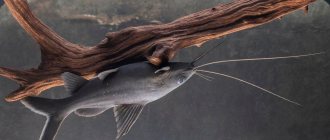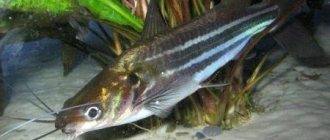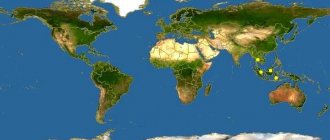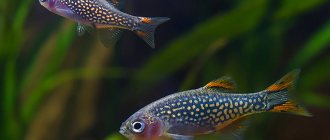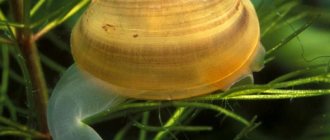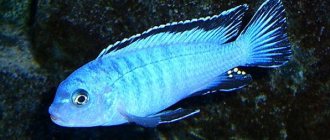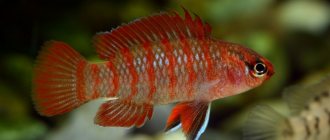5
(4)
Aquascaping has become an integral part of modern aquarium keeping. Now fish lovers carefully consider the design of their future aquarium before introducing fish into it.
One of the most popular aquarium plants, which is used by many aquascapers today, is flame moss. Aquarists are not even afraid of the fact that the plant does not adhere well to the substrate and they have to spend some effort to successfully place it in the container. However, in return, the aquarist receives an incredibly beautiful plant with high decorative properties. Flame moss is actively used in Japanese and Dutch style aquadesigns.
Moss content
Flame moss prefers cool water, around 20°C, but grows well in warmer water (up to 28°C). Soft or medium-hard water (4–9 dGH) is preferable for moss; the degree of “twisting” of the branches also directly depends on the hardness of the water. Water acidity is within the pH range of 5.5–7.5.
This moss can be grown without introducing carbon dioxide into the aquarium, but CO2 allows it to accelerate its development.
Prefers to be under a weak current of water.
Lighting from low to bright 0.25–0.5 W/liter, depending on the distance to the light source.
Flame moss grows very weakly to the substrate, so it must be tied to stones or snags with fishing line or secured with a net.
It does not require additional feeding and does not tolerate increased siltation very well.
Appearance
One of the most prominent representatives of taxiphyllums is flame moss. This unique aquarium plant is native to the cool waters of Central Asia. This beautiful plant has won the appreciation of aquarists for its unusual shape of shoots. Moss is very dense in structure, bright green, closer to dark, in color. Like all representatives of this genus, it grows vertically upward, spiraling in the process of growth and creating an image of a green fire with a cluster of shoots, logically justifying its name - flame. Moss has a very slow growth rate.
For aquadesign, this is, in some ways, a pleasant plus - it does not require frequent haircuts, preserving the compositional intent for a long time.
Decorating an aquarium using flame moss or “Flame Moss”.
Photo: “Flame Moss” grown on driftwood in the form of a tree.
Very often used for decorative aquariums. This is a plant for the middle and background of the aquarium.
Flame moss has a distinctive feature - weak growth to the substrate. Therefore, to decorate stones and driftwood, it is advisable to attach moss bushes to them with fishing line. This will allow you to move the decorations with the moss attached to them in the future. Due to the weak growth of flame moss in width, the decorations do not require maintenance for a long time and retain their beautiful appearance.
A mesh is used to cover horizontal areas or the back wall of the aquarium with moss. Using a mesh, moss can be secured to a certain area. Gradually the plant will grow and hide the mesh. But aquascapers don’t really like to use this moss to decorate the back wall due to poor attachment to the substrate.
This is convenient to do when there are a lot of “Flame Moss” crops; for successful design, you need to spread the moss evenly, immediately over the entire area of the grid, without hoping that it will grow later. Or if there is not very much of it, you will need to replant it later. If you have only a few branches of the “Flame Moss” crop, it is better to grow it on driftwood or stone, and decorate large areas when it grows.
Growth and development
In an aquarium, flame moss grows from 3 to 8 cm in height and 10 cm in width. The plant produces individual shoots that grow strictly in a vertical direction. They have a pointed shape and there are a lot of them. When they move along the flow of water, it seems that they are tongues of flame.
Rarely in an aquarium can moss reach a height of about 15 cm, but this is rather an exception to the rule. If the moss has become so tall, it is definitely recommended to trim it. The taller the plant, the worse its growth, since the branches simply will not have the strength to grow to the sides. When the plant reaches 8 cm in length, trimming is necessary.
If the moss has been planted on a net or secured with fishing line or string, it can be moved from one part of the aquarium to another over time. Flame moss is also unpretentious when transplanted to a new place, for example, to another artificial reservoir. Provided that all the necessary conditions for its existence are created, the plant is not prone to any diseases or wilting during the acclimatization period.
If a fairly mature plant is transplanted into a new aquarium, the only thing that can happen to it is that its growth will slow down or stop. This period of calm lasts for 1-2 weeks until the moss adapts to the new conditions. After which it will begin to grow and develop as usual.
When purchasing moss, it is recommended to plant it in old water; before planting it does not require preliminary replacement. This way the moss acclimatizes faster and immediately begins to take the necessary macro- and microelements from the water. If you plant a plant in freshly changed water or a completely new aquarium, recently equipped, in which its own microclimate has not yet formed, it is highly likely that the plant will not be able to acclimatize and will simply die.
Flame moss is an ideal aquarium plant. It is completely unpretentious; not only experienced aquarists, but also beginners can take care of it. Creating favorable conditions for him does not cause any difficulties. Clean water, filtration and good lighting are the 3 main conditions, under which moss will grow quickly and delight you with its rich green colors.
Moss flame in aquascaping
It is very popular in the middle and background of man-made water landscapes. True, during its initial breeding you have to work a little.
As already mentioned, this moss does not grow well into the ground, so it is usually fixed. Otherwise it will float up. You can attach it to snags, for example, with a colorless fishing line or a light cotton thread, which gradually dissolves in water just during the period until the moss rhizoids grow to the substrate.
To install Flame Moss to the bottom horizontal surface, a plastic mesh is often used. It is laid evenly on the area that is planned to be decorated, and a moss bush is carefully attached to it using transparent fishing line.
Since the flame almost does not grow in width, it does not need to be thinned out for a long time, and it does not require any feeding.
The image of a separate bright green tree can be created by attaching several moss bushes to the top of a vertical wooden element. By the way, it can be trimmed periodically so that the crown of such a “tree” looks even.
Very often taxiphyllum is planted on stones or wooden parts of the landscape. This makes it possible to move the “fire” bush from one place to another, depending on the aquadesigner’s plan.
In aquascapes, taxiphyllum is often combined with other plants and mosses. For example, in one zone, its proximity to spherical cladophores looks very original and beautiful.
There are a lot of options for placing a flame in the interior of an aquarium; most often it is used if it is necessary to emphasize any particular area of the landscape.
Flame Moss is an almost ideal living “material” for aquascaping. And this is due not only to its high decorativeness, but also to the ease of maintenance.
Common mistakes made by aquarists
Reasons that often cause the death of moss grass in an artificial home tank:
- Complete absence of soil. This natural biological filter is necessary for adequate nutrition of Mosses.
- Combination of Mosses and various types of mollusks. These underwater inhabitants actively eat moss fish.
- Association of mosses and large species of higher aquatic plants. They just start competing with each other.
- Introducing overly aggressive, predatory, bottom-dwelling and herbivorous fish into the tank with Mosses, actively destroying these plant forms.
Links[edit]
This article incorporates text from the following source, which (as a US Government work) is in the public domain: Tesky, Julie L. 1992. "Ceratodon purpureus". Fire effects information system. USDA, Forest Service, Rocky Mountain Research Station, Fire Science Laboratory.
- Flora of North America
- Profile views archived May 11, 2008, in the Wayback Machine
- US Forest Service fire ecology
- ^ a b Edwards, Sean R. (2012). English names of British bryophytes
.
Special issue of the British Bryological Society. 5
(4th ed.). Wootton, Northampton: British Bryological Society. ISBN 978-0-9561310-2-7. ISSN 0268-8034. - ^ abcdefgh Shaw, J.; Jules, E.S.; Beer, S.C. 1991. Effects of metals on the growth, morphology and reproduction of Ceratodon purpureus. Bryologist. 94 (3): 270-277.
- ^ ab Bland, John H. 1971. The Forests of Lilliput. The kingdom of mosses and lichens. Englewood Cliffs, NJ: Prentice-Hall, Inc.
- ^ abcde Dunham, Elizabeth Marie. 1951. How to Identify Mosses: A Popular Guide to the Mosses of the United States. Boston, MA: The Mosher Press.
- ^ ab Grout, A. J. 1932. Moss flora of North America, north of Mexico. Vol. 3. Part 3. New York: Author.
- ^ ab Post, A. 1990. Photoprotective pigment as an adaptive strategy in the Antarctic moss Ceratodon purpureus. Polar biology. 10 (4): 241-246.
- ^ abcd Ireland, RR 1982. Moss flora of the maritime provinces. Publications in Botany No. 13. [Ottawa, Ontario]: National Museum of Natural Sciences.
- ^ abcdefg Richardson D.H. 1981. Biology of mosses. Oxford: Blackwell Scientific Publications.
- ^ ab Pérez, Francisco L. 1991. Ecology and morphology of the globular moss Grimmia longirostris in the Páramo de Piedras Blancas, Venezuelan Andes. Arctic and alpine research. 23 (2): 133-148.
- Olesen, Peter; Mogensen, Gert Steen. 1978. Ultrastructure, histochemistry and notes on the stages of spore germination in selected mosses. Bryologist. 81 (4): 493-516.
- ^ ab Auclair, I 1983. The role of fires in lichen-dominated tundra and forest-tundra. In: Wein, Ross W.; McLean, David A., ed. The role of fires in northern circumpolar ecosystems. Volume 18. New York: John Wiley & Sons: 235-256.
- ^ ab Rosenstiel, TN; Shortlidge, E. E.; Melnichenko, AN; Pankov, J.F.; Eppley, S.M. (2012). "Sex-specific volatile compounds influence microarthropod-mediated moss fertilization." Nature
.
489
(7416):431–433. DOI: 10.1038/nature11330. PMID 22810584. - Hall, Christine N.; Kuss, Fred R. 1989. Vegetation changes on trails in Shenandoah National Park, Virginia. Biological conservation. 48: 211-227.
- Klinka, K.; Krajina, V.J.; Ceska, A.; Scagel, A. M. 1989. Indicator plants of coastal British Columbia. Vancouver, BC: University of British Columbia Press.
- Cormack, R. G. H. 1953. A survey of the succession of coniferous forests in the eastern Rocky Mountains. Forestry Chronicle. 29: 218-232.
- Viereck, Los Angeles; Dyrness, Conn., 1979. Ecological consequences of the Wickersham Dome fire near Fairbanks, Alaska. Gen. Tech. Representative PNW-90. Portland, OR: US Department of Agriculture, US Forest Service, Pacific Northwest Forest and Range Experiment Station.
- ^ a b Crane, MP; Habeck, James R.; Fisher, William C. 1983. Early vegetation recovery after fire in a Douglas fir forest in western Montana. Res. Dad. INT-319. Ogden, Utah: US Department of Agriculture, Forest Service, Intermountain Forest and Grassland Experiment Station.
Description of the plant
Flame moss or, as many call it, Flame moss is a unique plant that belongs to the group of hypnotic mosses. It has a unique appearance, which is why it is actively used in decorating aquariums.
What does it look like
Most types of moss plants grow in different directions, covering the surface like a carpet. But the moss flame grows strictly vertically. This is its main feature. But because of this, the owner of the aquarium may face some inconveniences. For example, a plant is poorly attached to the bottom of the tank, so it can break off from the ground and float freely. Over time, such floating leads to the death of the plant.
What does moss flame look like?
The height of the branches rarely exceeds 15 cm; most often in aquarium conditions, moss does not exceed the 8 cm mark. Moss branches are thin shoots that, twisting in a spiral, neatly intertwine with each other. Externally, the plant strongly resembles green flames moving in water.
Where does it live?
The rivers of southeastern Asia are considered the birthplace of flame moss. The plant mainly lives in bodies of water with weak currents. These are unpretentious creatures that grow in separate bushes. They thrive in different temperatures as well as different light intensities.
The rivers of southeastern Asia are considered the birthplace of flame moss.
Distinctive features
Moss does not have a pronounced root system, so the plant receives all its nutrients through special thin shoots - rhizoids . Using shoots, Flame moss is attached to the bottom of the aquarium. The shoots themselves are very thin and weak, so even a slight current, provoked by an aquarium filter , can lead to the plant being torn off from the snags or soil .
Moss does not have a pronounced root system
Note! Like most types of moss, Flame moss grows quite slowly. But it does not require regular haircuts, due to which the original design in the aquarium is preserved for a long period.
How to fix moss, anubias, bucephalandra in an aquarium
Nitrates in the aquarium: how to reduce, check, fight and maintain
The smallest aquarium fish: types and care for them
TOP 20 most beautiful aquarium fish
TOP 12 most expensive aquarium fish
Aquarium fish that do not spawn, but give birth to fry
The water in the aquarium becomes cloudy: the reason, how to eliminate it
Heater for an aquarium. Temperature in the aquarium
Interesting facts about mosses
Many interesting facts are known about these unique ancient plants of the Earth:
- Moss mushrooms are one of the few forms of terrestrial fauna that grow on absolutely all continents of the planet.
- Even moss, which is food for reindeer, is also one of the varieties of mosses.
- Without a root system, mosses absorb nutrients from their environment with their entire surface.
- It grows only in humid areas, so it does not exist in desert areas.
- Reproduces sexually and with the help of spores.
- The only other species on Earth that are older than mosses are algae. But it was the ancestors of the moss grass that became the first terrestrial forms of plants 400 million years ago.
- Mosses do not have flowers.
- This plant can come to life even after complete freezing. Thus, a piece of Moss found in Antarctica, frozen into ice more than 1.5 thousand years ago, came to life when defrosted.
- The most diverse and numerous forms of Mosses grow in trails and wet forests.
- The appearance of peat in swamps occurs due to mosses.
- Moss decoration originated in ancient China.
- Sfangnum peat mosses continuously die off (lower parts) and grow (by a millimeter per year) and their total lifespan is more than 2 thousand years. In other species it is at least 10 years.
Fertilizers
For good growth and development of Java moss, fertilizers are necessary. A lack of microelements leads to an unhealthy yellowness of the stem, or even to its blackening. The concentration of CO2 and nitrogen in the reservoir should be increased.
For good moss growth, it is necessary to increase the nitrogen concentration in the reservoir.
The main thing is not to exceed the concentration of fertilizers, because its excess leads to the growth of filamentous algae, which is unsafe for moss.
Root feeding is not used due to the fact that the aquatic organism does not take root.
Moss that is grown according to the recommendations will become a wonderful living corner or decoration for any aquarium. He interacts wonderfully with aquatic inhabitants. Attaching it to interesting details will be fun, and the aquarist will want to change the interior of the aquarium once again.
Do you have Java moss in your aquarium? What composition did you create with him? Share your experience with other aquarists in the comments.



